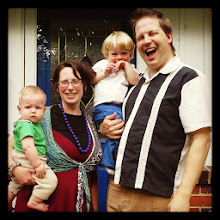Building Raised Garden Beds
Here's what we did:
Step 1: Gather untreated wood in proper dimensions
For us, this was a combination of reclaimed wood off Freecycle and new wood from Home Depot. All three of our beds are 4x4 feet. Two are six inches deep and one is eight inches deep to accommodate carrots. I really riled up Mr. Random Customer behind me in the wood-cutting line at Home Depot by getting untreated wood, which will eventually rot away. We figure, better to replace it in a few years than to have chemicals from treated wood leeching into our organic veggie garden. He was shocked by the idea of letting the wood rot and re-found us four times in the store to give us new ideas of how to prevent the wood from rotting. We stuck to our original plan. I really struggled with buying conventional wood, but I could not find lumber that was the right dimensions and Forest Stewardship Council (FSC) (or the like) certified, save for one bed-building kit at Home Depot that came with—oh irony—treated wood.
Step 2: Mark Starter Holes
Ascertain the width of the boards. Half of that distance is where you will make your mark. Our boards were 1.5 inches thick so our marks needed to be ¾ inch from the end of the board. Spatial things are my kryptonite and this did not initially make sense to me, but hubby explained that this will line the screws up precisely in the middle of the adjoining board in the next step.
Step 3: Bore Starter Holes
Pick the drill bit that is the appropriate size for your screws (be sure to use galvanized/outdoor screws). We bored three starter holes in each board. All three should be in a row go all the way through the width of the board. You will only make holes on one side of the board.
Step 4: Outline the bed
Lay the boards in the shape of the bed.
Place sides with holes against sides without holes.
Step 5: Prepare Middle Pilot Hole 1
Make a pilot hole to prevent the wood from cracking when you put in the screw: with the drill bit, drill through the middle hole of one board squarely into the middle of the adjoining board.
Step 6: Insert Middle Screw 1
Now, put in your first screw.
Step 7: Address remaining middle holes
Create a pilot hole and insert the screw for each of the remaining three middle holes. Drill and screw at each corner before moving to the next one, as your wood will shift slightly each time and pre-drilled pilot holes may not line up.
Step 8: Address remaining holes
Create a pilot hole and insert the screw for each of the eight remaining holes (two at each corner). Now that the frame's shape is secure, you do not have to keep alternating between pilot holes and screws. Drill all remaining pilot holes at once; then do a round of just inserting screws.
Step 9: Place the bed in the yard and watch the sun
The bed is empty and light now. So, place the bed then watch the sun on it. On a day I was home all day, I set a timer and on each hour I made notes as to the sun conditions and then checked back in another hour. The empty beds are easy to move if one position doesn't work out.
Optional Step: Create a bottom
(visible in picture above)
We are concerned about moles and groundhogs digging up into our beds, so we decided to put a galvanized wire "hardware cloth" bottom on the two beds that will be in the backyard.
- Decide which side you want to be the top of the bed and put that side face-down.
- With the bottom of the bed facing up, line up one edge of the hardware cloth with one edge of the bed, centering it.

- Fold the sharp ends of the wire under. Staple-gun the wire down, using just a few staples.
- Unroll the wire to reach the opposite side of the bed.
- If the wire is too long, you could cut it, but we chose to simply fold it over.Make sure the hardware cloth is lined up to amply cover the remaining two sides.
- If the wire will not line up, remove the staples on the first side with needle-nose pliers and try again. If it does line up, staple-gun the wire down.
- Then, heartily staple down all four sides.
Cost
Lumber for three beds $26 (plus the free wood from Freecycle)
Galvanized screws= nominal cost, about $0.50
Hardware cloth for two beds: $26
Subtotal: $52.50
Still to be determined: supplies to keep the squirrels and birds away…
Labels: Gardening














0 Comments:
Post a Comment
Subscribe to Post Comments [Atom]
<< Home